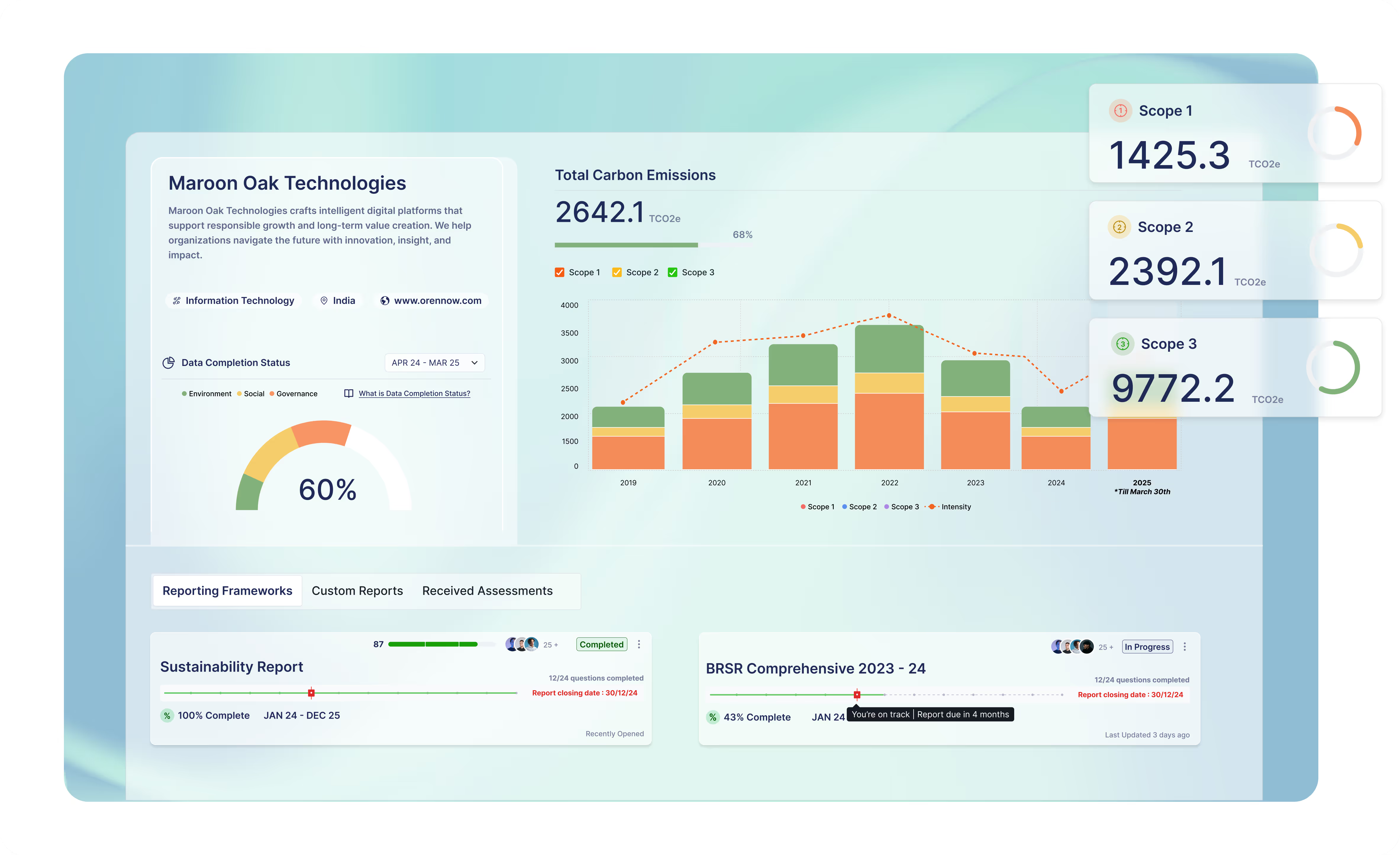Environmental Sustainability: Principles, Pillars & Strategy

The rise in climate change, deforestation, and resource depletion has become common news we are being exposed to. While individual and family contributions are significant, businesses urgently need major and effective measures to control the problem.
To ensure the protection of nature and the planet, the focus on environmental sustainability practices is highly important. Ensuring enough support for the cause and offering a plethora of associated benefits, detailed insights into what, how, and more are crucial. Let us help you gain the necessary knowledge for informed decision-making and explore sustainability initiative examples to create long-term impact.
Environmental Sustainability Definition
Environmental sustainability is defined as the responsible use and management of natural resources to meet current human needs while maintaining ecological balance. The aim is to ensure there are sufficient resources available for future generations. The natural resources in consideration here include clean air, water, wildlife, forests, etc.
Pillars of Sustainability
Three pillars of sustainability function together to create a balanced and sustainable future for both people and the planet. Here are the insights into the same:
1. Social Sustainability
It focuses on people and communities and involves ensuring fair treatment and equal opportunities for everyone. This pillar also supports inclusion, employee empowerment, and a good work-life balance. Prioritising these values helps organisations build trust and long-term loyalty among employees and stakeholders through meaningful environmental sustainability initiatives.
2. Economic Sustainability
It ensures that businesses remain profitable and grow responsibly. Further, it supports generating long-term value without harming people or the environment. Economically sustainable companies invest in innovation, efficient resource use, and fair business practices that benefit society while aligning with principles of environmental sustainability.
3. Environmental Sustainability
This pillar of sustainability emphasises protecting the planet for future generations. It involves measures like waste reduction, resource conservation, and pollution minimisation. Many organisations are now adopting advanced technologies such as cloud computing and IoT to track and lower their carbon footprint. Adopting these serves as real-world environmental development examples of responsible progress.
Why is Environmental Sustainability Important?
The utmost reason for the importance of environmental sustainability lies in its being one of the biggest hopes for accessibility to clean resources for future generations. It is also a promising approach to reverse the climatic disasters and climate change. Here are the detailed insights into why it is important:
1. Protects the Natural Resources
Environmental sustainability ensures that natural resources such as air, water, soil, and others are preserved and used responsibly. It promotes conservation practices that prevent resource depletion. These ecological sustainability examples highlight the importance of applying responsible resource management across industries.
2. Offers Economic Benefits
Measures towards environmental sustainability support the use of renewable energy sources and efficient technologies. It reduces the dependence on finite resources that hurt the environment. The result is cost savings coupled with energy efficiency and long-term business growth without harming the planet. The benefits are further amplified when implemented in large-scale businesses and enterprises.
3. Improves Quality of Life
Sustainable practices also address key social issues such as pollution, health, improper waste management, education, and others. Working on the same offers a safe and secure environment to thrive in for both humans and animals. These environmental sustainability initiative examples offer clean resources that support life to flourish.
What Can Businesses Do to Achieve Environmental Sustainability?
The measures that can support businesses in achieving environmental sustainability practices are:
- Reduce environmental impact by switching to energy-efficient appliances and renewable energy sources.
- Monitoring supply chains to ensure ethical sourcing and minimise environmental harm. Businesses should partner with vendors that use eco-friendly materials and align with environmental sustainability strategy goals.
- Adopt innovative mechanisms that support environmental sustainability. These must be capable of reducing carbon emissions across the supply chain while making a quality impact in the long run.
- The processes and products must be designed for longevity, easy recyclability, and minimal waste generation. It helps reduce landfill burden and promotes responsible consumption.
- Collaborate with or invest in brands that prioritise sustainability. It enhances the positive impact and encourages industry-wide change.
- Adopt the United Nations’ 17 Sustainable Development Goals (SDGs). It provides a global framework that aligns with principles of environmental sustainability and environmental sustainable development examples. The examples include climate action and life on land initiatives.
What is ESG?
Environmental, Social, and Governance, or ESG, plays a key role in driving environmental sustainability by encouraging businesses to adopt eco-friendly practices. It is a framework that helps assess how a company performs in areas beyond financial success. It evaluates how businesses manage their environmental responsibilities, treat people, and uphold transparent governance practices.
- The environmental aspect focuses on environmental sustainability topics like reducing carbon emissions and conserving natural resources.
- The social aspect involves fair labour practices, diversity, and community engagement.
- The governance aspect covers ethics, broad structure, and transparency.
ESG is becoming a standard for investors and stakeholders who seek sustainable, responsible, and long-term value creation in businesses. It depicts the company’s commitment to operating ethically while balancing profit with purpose.
Benefits of ESG
Investing to ensure quality performance in ESG helps businesses gain benefits in a variety of aspects. Here are the insights into the same:
1. Offers Competitive Advantage
ESG-focused organisations stand out in the market among their competitors. It is due to the strong brand reputation, fostering innovation, and appealing to sustainability-conscious consumers.
2. Improves Financial Performance
Reducing energy consumption, waste, and operational costs helps effectively manage the costs to the company. It improves profitability and develops long-term financial resilience. Thus, it supports the environmental sustainability solutions that drive long-term profit.
3. Attracts Investors and Lenders
The references to ESG frameworks attract the investors who prioritise stable, responsible, and low-risk opportunities. Transparent ESG reporting also helps gain the trust of investors in businesses.
4. Employee Engagement and Retention
ESG encourages a culture that values diversity, inclusion, and purpose. These qualities in a business are key to attracting top talent and promoting long-term employee satisfaction.
Conclusion
Environmental sustainability initiatives are the need of the hour to shape the future of humanity and the planet. It requires mutual agreement and action of individuals, organisations, and governments to make Earth a healthy place to thrive on.
Planning and implementing in the right direction can mitigate climate risks, preserve biodiversity, and ensure access to essential resources for future generations. Further, integrating ESG principles strengthens this commitment by linking sustainability with transparency, ethics, and innovation.
Frequently Asked Questions
Which is an example of environmental sustainability?
The common ecological sustainability examples include improving waste management, using renewable energy, practising crop rotation, and others.
What are the 4 types of sustainability?
The four types of sustainability are environmental, social, economic, and human. These types focus on preserving natural resources and encourage long-term economic stability.
What are the four functions of environmental sustainability?
The four functions of environmental sustainability are resource conservation, pollution control, waste reduction, and ecosystem protection. It helps maintain long-term environmental balance.
Give a real-life example of environmental sustainability.
A leading example of environmental sustainability is Patagonia. The brand promotes eco-consciousness through its ‘Worn Wear’ program, encouraging cloth repair. It also uses over 70% recycled materials and donates 1% of sales to environmental causes. Patagonia also runs campaigns like ‘Don’t Buy This Jacket,’ thus advocating responsible consumption.
What is environmental sustainability in the Indian context?
In India, environmental sustainability initiatives focus on balancing rapid economic growth with responsible resource use and clean energy adoption. It also comprises controlling pollution to safeguard the natural ecosystem.
Latest Blog Posts
Dive into our blog for insights on making your organization more sustainable.
Sustainability Simplified
Wherever you are in your sustainability journey, we help you advance with confidence.
Schedule a Call

.avif)


